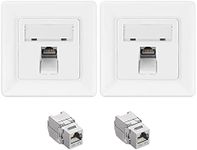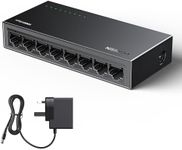Buying Guide for the Best Ethernet Switches
Choosing the right Ethernet switch can significantly impact the performance and reliability of your network. Ethernet switches are essential for connecting multiple devices within a local area network (LAN) and managing data traffic efficiently. When selecting an Ethernet switch, it's important to consider various specifications that align with your network requirements and future growth plans. Here are some key specifications to help you make an informed decision.Port CountThe port count refers to the number of devices that can be connected to the switch. This is important because it determines the scale of your network. Ethernet switches typically come with 5, 8, 16, 24, or 48 ports. For small home networks or small offices, a switch with 5 to 8 ports may suffice. Medium-sized networks might require 16 to 24 ports, while larger enterprises may need 48 ports or more. Consider your current number of devices and potential future expansion when choosing the port count.
SpeedEthernet switches come in different speed ratings, such as Fast Ethernet (100 Mbps), Gigabit Ethernet (1 Gbps), and 10 Gigabit Ethernet (10 Gbps). The speed determines how quickly data can be transferred between devices. For most home and small office networks, Gigabit Ethernet is sufficient and provides a good balance of speed and cost. However, if you have high-bandwidth applications like video streaming or large data transfers, you might consider a switch with 10 Gigabit Ethernet capabilities.
Managed vs. UnmanagedManaged switches offer advanced features like VLANs, QoS, and network monitoring, allowing for greater control and customization of your network. Unmanaged switches are simpler and plug-and-play, with no configuration required. Managed switches are ideal for larger or more complex networks where you need to prioritize traffic and ensure security. Unmanaged switches are suitable for smaller, straightforward networks where ease of use is a priority.
PoE (Power over Ethernet)PoE switches can deliver power to connected devices, such as IP cameras, wireless access points, and VoIP phones, through the Ethernet cables. This eliminates the need for separate power supplies for these devices. PoE is important if you want to simplify your network setup and reduce cable clutter. If you have or plan to have PoE-enabled devices, choosing a switch with PoE capabilities can be very beneficial.
Switching Capacity and Forwarding RateSwitching capacity refers to the total bandwidth that the switch can handle, while the forwarding rate is the number of packets the switch can process per second. These specs are important for understanding the switch's performance under heavy traffic. Higher switching capacity and forwarding rate are crucial for networks with high data transfer demands. For typical home or small office use, standard switching capacity and forwarding rates are usually sufficient. For larger networks with heavy traffic, look for switches with higher values in these areas.
Layer 2 vs. Layer 3Layer 2 switches operate at the data link layer and are responsible for switching data within the same network. Layer 3 switches have routing capabilities and can manage traffic between different networks. Layer 2 switches are suitable for simple, single-network environments, while Layer 3 switches are better for more complex networks that require inter-network communication. Choose based on whether you need basic switching or advanced routing features.


















